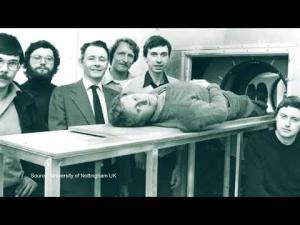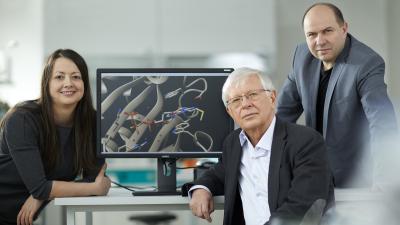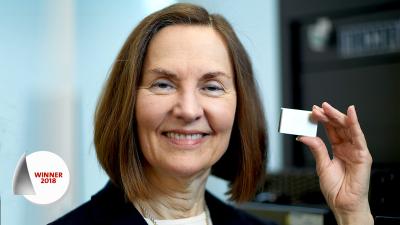Jens Frahm
Faster, real-time MRI
Winner of the European Inventor Award 2018
Magnetic resonance imaging (MRI) is one of the world's most widely used diagnostic tools. The road to success was paved by a revolutionary scanning technique known as fast low angle shot (FLASH). Perfected by German physical chemist Jens Frahm in 1985, FLASH accelerated MRI scans by a factor of 100. Reducing scanning time from half a day to a few minutes, it soon became the clinical standard. The inventor's follow-up, FLASH 2, delivers the first moving MRI images in real time at up to 100 frames per second
Before Frahm's game-changing invention, MRI was still unsuitable as a diagnostic tool. When the first human MRI scan was conducted in 1977, it took four hours and 45 minutes to create a three-dimensional image - much too slow for medical practice.
Providing the speed boost, Jens Frahm at the Max Planck Institute for Biophysical Chemistry in Göttingen devised an ingenious principle in the early 1980s: FLASH flips the atoms that are aligned with the magnetic field at a shallower angle, thus allowing for ultra-short signal pulses fired in rapid succession and hence faster scans. As a result, MRI scanners can collect all necessary exposures for a three-dimensional image in just a few minutes, and two-dimensional images within seconds.
The rest is history. Leading manufacturers adopted the patented technology within months of publication and the number of installed MRI scanners grew significantly worldwide.
"The imaging method we developed at the time has formed the basis for all clinical magnetic resonance applications worldwide," says the inventor. In 2010, Frahm presented the follow-up invention: FLASH 2 pairs the FLASH principle with modern-day computer image reconstruction to achieve recording speeds of up to 100 frames per second, moving MRI from photography to video.
Societal benefit
Accelerated by FLASH technology, MRI scanners quickly became the new status quo in medical imaging by delivering high-resolution, three-dimensional images of sensitive areas such as the brain, heart and abdomen without the harmful radiation associated with X-rays.
Today, more than 100 million MRI procedures, all using the FLASH method, are performed every year around the world. That is three MRI scans every second. In global healthcare ratings, the availability of MRI procedures is an important benchmark of quality care. Worldwide, there are 36 000 MRI machines. In Germany alone, the number of MRI procedures in ambulatory care almost tripled from 38 procedures performed per 1 000 inhabitants in 2000 to 108 procedures in 2014.
Patients also stand to benefit from FLASH 2, which is currently undergoing clinical tests in Germany, the UK and the United States. It provides the first-ever three-dimensional videos of pumping hearts, moving joints and complex processes like swallowing or speech formation. "We can now visualise physiological processes that we have never seen before," says Frahm. FLASH 2 has already yielded 50 doctoral theses along with fresh diagnostic insights.
Economic benefit
Frahm's discoveries resulted in key patents for the FLASH method, granted in 1987 in the United States and in 1989 in Europe. But the patents initially yielded no profits, because three of the largest manufacturers used the technology without a licence. By 1993, the Max Planck Society had spent nearly EUR 1.5 million in a successful seven-year legal battle on all continents.
Today, the FLASH platform is the Max Planck Society's most profitable patent asset and has generated a reported EUR 155 million in licensing revenue to date. Royalties from both FLASH and FLASH 2 go straight into research, funding a not-for-profit organisation specifically created for Frahm's research in 1993 at the Max Planck Institute for Biophysical Chemistry in Göttingen.
Analysts at MarketsandMarkets estimated the global market for MRI systems at EUR 4.7 billion in 2016. The market is projected to reach EUR 6 billion in 2021 at a compound annual growth rate of 5.1%.
How it works
Water is found throughout the body (e.g. in tissue, organs and fat), and MRI relies on the properties of the hydrogen nuclei in water. The patient is put in the MRI scanner's strong magnetic field and the hydrogen atoms in the body's water molecules align with the field. These atoms are then "flipped" out of alignment by a radio frequency pulse.
After the pulse, the hydrogen atoms "relax" back into the magnetic field, emitting radio waves that are picked up by the MRI scanner and rendered into images by a mathematical transformation. The first MRI devices required over 200 individual data recordings - meaning exposures to the magnetic field - to fully render one cross-section of a patient's body. The lengthy procedure also required a delay of several seconds between each radio pulse to allow the nuclei to recover.
Radically shortening imaging times, Frahm's FLASH technique uses only a small portion of the MRI signal for each of the many individual measurements. The concept eliminates long delays between pulses, enabling repetitive measurements every 2 to 10 milliseconds, with pulses flipping atoms through a shallower angle of just 5 to 15 degrees instead of 90 before they relax to magnetic alignment.
Frahm's "fast low angle shot" completes cross-sectional images in about one second, and reduced the measuring times of three-dimensional image recordings from at least half a day to a few minutes.
For the world's first moving MRI images, FLASH 2 uses an ingenious trick: because differences between individual frames are minimal, it records only a small number of images - around 5 to 15 instead of 200 exposures. Reconstruction algorithms then "fill in the blanks" to create seamlessly moving pictures.
The inventor
Jens Frahm embarked on his lifelong path of integrating chemical and physical research as a physics student at the Georg August University of Göttingen, Germany. For his 1977 PhD thesis in physical chemistry, he explored the medical uses of a then brand-new concept called nuclear magnetic resonance (NMR) spectroscopy, the core technology behind MRI.
Today, Frahm heads his own MRI research laboratory as Director of Biomedizinische NMR Forschungs GmbH at the Max Planck Institute for Biophysical Chemistry in Göttingen, a position he has held since 1993. A current - perhaps surprising - project studies sound formation in brass instruments, such as the horn, using FLASH 2. Musical education textbooks are already being rewritten as a result of the findings. MRI films have revealed the active role of the human tongue in what have always been referred to as "lip-vibrated" instruments. A footnote should include that Frahm is an avid clarinet player, and at one time received training from the Staatstheater Oldenburg.
Regarded as an institution in his field, the prolific Frahm is the author of over 470 scientific publications, including papers detailing fundamental principles behind FLASH and FLASH 2. He holds an h-index score of 87 and is listed as the inventor on four granted European patents.
Frahm's honours include the Gold Medal Award of the International Society for Magnetic Resonance in Medicine (1991), European MRI Award of the German Roentgen Society (1989) and Jacob Henle Medal (2016). In 2016, Frahm was inducted into the German Research Hall of Fame, an honour which has been conferred on only 20 scientists.
"I've worked all my life on MRI. For me as a physicist, this is a fascinating opportunity to do something useful, something meaningful, that benefits millions of people," Frahm says.
Did you know?
It's a little-known fact that some of today's most widely used medical diagnostic tools owe their existence to space programmes. Both computer-aided tomography and MRI are based on digital image processing technologies developed and refined by NASA to survey the surface of the moon in preparation for the Apollo lunar landing.
These technologies from space exploration were later successfully converted into terrestrial uses thanks to spin-off innovations like Frahm's FLASH imaging principle. The impact of out-of-this-world inventions extends far beyond medicine. The European Space Agency (ESA) has brought organic membranes for water recycling, remote-controlled emergency response robots and image analysis software for the repair of wind turbines back to Earth. Even bathing has become more eco-friendly as a result of space water conservation studies. In Sweden, Mehrdad Mahdjoubi has created a new shower technology that uses only five litres of water per use while continuously filtering the water to make it even cleaner than from the tap.
Landing space technologies on Earth is also big business. According to the ESA, technology transfer from space inventions creates 1 500 jobs and revenues of EUR 80 million per year. This is between 15 and 20 times the amount spent by ESA member states on the space programme.
Media gallery
Contact
European Inventor Award and Young Inventors Prize queries:
european-inventor@epo.org Subscribe to the European Inventor Award newsletterMedia-related queries:
Contact our Press team#InventorAward #YoungInventors









